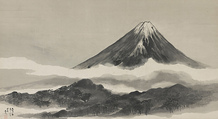Returned to lender The Met accepts temporary loans of art both for short-term exhibitions and for long-term display in its galleries.
Mt. Fuji
Tani Bunchō Japanese
Not on view
Standing at the center of the Japanese archipelago and rising higher than any other mountain in the country, Mt. Fuji has been revered since ancient times. The people of Edo in particular venerated Mt. Fuji as a sacred peak, and for them its triangular form on the western horizon provided a source of majestic serenity. The Edo literati artist Bunchō sketched famous mountains throughout Japan and published his drawings in the woodblock-printed book, Album of Famous Mountains (Meizan zufu; 1804). The illustration of Mt. Fuji in the book depicts it at a further remove than in this painting, but otherwise the two representations are essentially the same. This similarity and the line of rolling clouds suggest that the painting is based on a sketch drawn with the mountain directly in view. This painting is dated the tenth month of 1802, two years before the Album of Famous Mountains. Bunchō was 40 and just reaching the prime of his career.
This image cannot be enlarged, viewed at full screen, or downloaded.
This artwork is meant to be viewed from right to left. Scroll left to view more.




